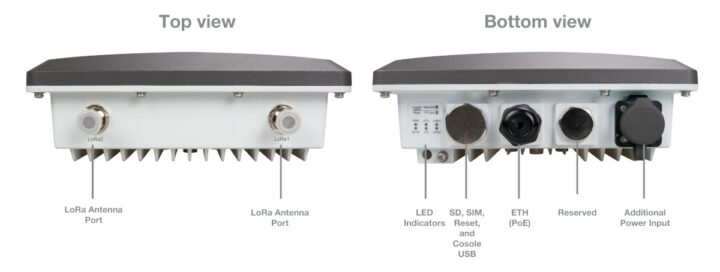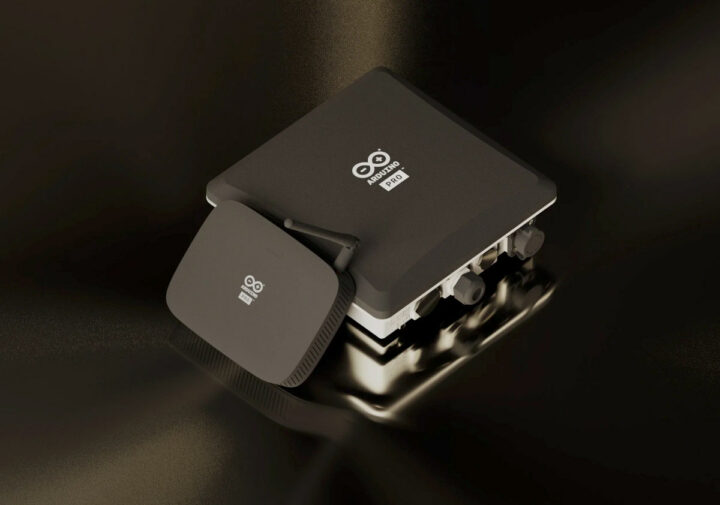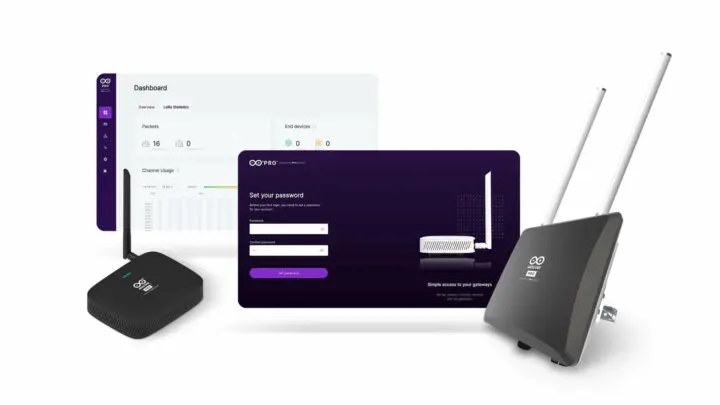Arduino was already involved in LoRaWAN with its MKR WAN 1300 board, but now the company has started offering Arduino-branded Wisgate Edge Pro and Wisgate Edge Lite 2 LoRaWAN gateways for respectively outdoor and indoor environments as part of the Arduino Pro family.
If the names of the gateways seem familiar, it’s because Arduino collaborated with Rakwireless, and is simply using their existing LoRaWAN gateways. As I understand it RAKwireless will provide the hardware and technical support, while Arduino will sell the gateways and other LoRaWAN hardware through its existing customer base, more acting as a distributor.
Arduino WisGate Edge Lite 2 indoor gateway specifications:
- SoC – MediaTek MT7628 MIPS processor @ 580 MHz
- System Memory – 128MB DDR2
- Storage
- OS on flash
- SD card for setup and diagnostics, backup, and data logging
- Connectivity
- 10/100M Ethernet RJ45 port
- 2.4 WiFi (802.11b/g/n) with -95 dBm RX sensitivity, 20dBm Tx power; internal antenna
- LoRa radio via SX1302 Mini PCIe card
- 8 channels
- RX Sensitivity – -139 dBm (Min)
- TX Power – 27 dBm (Max)
- Support for EU868, US915, or AS923 & AU915 bands (depends on selected SKU)
- Extra – Listen Before Talk
- RP-SMA female connector
- Optional 4G LTE
- USB – USB Type-C port for access to console
- Power Supply
- 12V/1A via DC jack (Power supply Included)
- 36-57V DC via PoE (IEEE 802.3 af)
- Consumption – 12W typ.
- Dimensions – 166 x 127 x 36 mm
- Weight – 300 grams
- Temperature Range – -10ºC to +55ºC
- Protection Rating – IP30
The WisGate Edge Lite 2 is designed to be wall-mounted.
Arduino WisGate Edge Pro outdoor gateway specifications:
- SoC – MediaTek MT7628 MIPS processor @ 580 MHz
- System Memory – 128MB DDR2
- Storage
- OS on flash
- SD card for setup and diagnostics, backup, and data logging
- Connectivity
- 10/100M Ethernet RJ45 port
- 2.4 WiFi (802.11b/g/n) with -95 dBm RX sensitivity, 20dBm Tx power; 2×2 MIMO internal antennas
- LoRa radio via SX1302 Mini PCIe card
- 16 channels
- RX Sensitivity – -139 dBm (Min)
- TX Power – 27 dBm (Max)
- Support for EU868, US915, or AS923 & AU915 bands (depends on selected SKU)
- Extra – Listen Before Talk
- 2x external fiberglass 5dB antennas with N-Type connectors
- Optional 4G LTE
- GPS support
- USB – USB Type-C port for access to console
- Power Supply
- 12V/1A via DC jack (Power supply included) or solar panel
- 36-57V DC via PoE (IEEE 802.3 af)
- Consumption – 12W typ.
- Dimensions – TBD
- Weight – TBD
- Temperature Range – -30ºC to +55ºC
- Protection Rating – IP67
All connection plugs are to NEMA-6 standard to ensure dust and waterproofness. The Edge Pro gateway is offered with optional on-pole and DIN-rail installation kits.

Both gateways have a similar base and run the WisgateOS 2 operating system based on OpenWrt, but the Pro model offers more antennas and LoRa channels, and features specific to outdoor operation such as a wider operating temperature range, IP67 ingress protection rating, solar panel power input, and well as GPS support. The dashboard of the gateways has been customized with Arduino Pro branding as well.
The product page on the Arduino website has limited information, and it does not appear to be available for sale yet, instead asking customers to join a waiting list. Arduino highlights the “comprehensive technical documentation by RAKwireless“, so that’s probably where users should look for technical details and get started. While Arduino has not announced pricing, we can always refer to RAKwireless’ own prices with the RAK7289 WisGate Edge Pro going for $372.00 and up, and the RAK7268\RAK7268C WisGate Edge Lite 2 for $139.00 and up depending on the options such as 4G LTE.
Via CNX Software China and Arduino Blog

Jean-Luc started CNX Software in 2010 as a part-time endeavor, before quitting his job as a software engineering manager, and starting to write daily news, and reviews full time later in 2011.
Support CNX Software! Donate via cryptocurrencies, become a Patron on Patreon, or purchase goods on Amazon or Aliexpress






